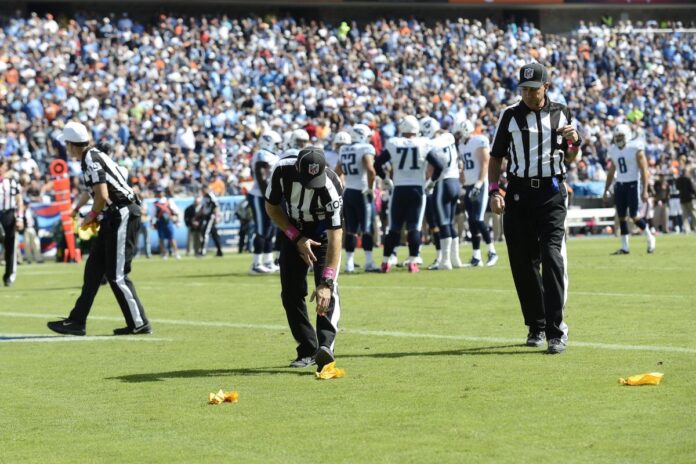The weekly surge in flags thrown in NFL games is detrimentally affecting the quality of the sport. This fact is becoming increasingly undeniable.
Chances are, you’ve come across the statistics. According to the league, NFL games now average approximately 17 penalties per match, a notable increase from the 14.7 recorded at this same point in the previous season.
The enforcement of illegal contact, which was emphasized this season, has surpassed the total calls made for it in the entire previous season within just six weeks.
However, it’s not limited to illegal contact; it extends across various aspects of play.
NFL Vice President of Officiating Dean Blandino recently expressed satisfaction with the current affairs.
I respectfully disagree. Since when did a sport’s success hinge on how frequently it’s interrupted by those not actively participating in the game?
Fans have every right to feel frustrated. The primary issue lies in the deluge of penalties, which disrupts the game flow, resulting in a frustrating, start-and-stop, disjointed viewing experience.
There’s no cohesion or flow to the game anymore. With the incessant flag throwing, it’s downright exhausting to watch.
Consider the typical NFL enthusiast: typically aged between 25 and 45, dedicating a strenuous 40-50+ hours per week to their job to support their family.
When Saturday arrives, it is often filled with non-work-related responsibilities and engagements, such as tending to household chores like mowing the lawn or attending their children’s baseball games.
Ah, Sunday, the sanctuary. By 1 p.m., it’s time to unwind on the couch, recharge for the week ahead, and savor the sport.
However, relaxation seems elusive nowadays. Watching a game has morphed into an uphill task in itself. Not even three minutes pass without a pause for a penalty, a replay, or a commercial break.
The game lacks coherence and fluidity. The incessant flag-throwing has turned it into an utterly draining experience.
One must endure through the ceaseless stoppages, enduring seventeen replays, then engage in a mental exercise, dissecting the process, the rule emphasis, and questioning why it’s even considered a penalty in the first place.
The rules have become incredibly subjective, numerous, and intricate.
Even seasoned analysts, devoted fans, and referees struggle to pinpoint exactly why a penalty was called.
Personally, when I’m unwinding and watching a game, I prefer not to dwell too much on the intricacies—I just want to relish the experience.
Consider this: television networks now find it necessary to enlist the expertise of former Vice President of Officiating Mike Pereira to dissect the intricate nuances of a rule after every flag is thrown.
The complexity is such that even seasoned analysts are often left scratching their heads.
I sympathize with defensive players restricted from executing their primary role-playing defense.
What’s particularly exasperating is the hunger that ensues whenever there’s a resounding collision on the field.
Flags are thrown based on the sheer impact of the play rather than a clear-cut infraction.
In the recent Bengals/Panthers game, I witnessed no fewer than four personal foul-related calls for helmet-to-helmet, targeting, or hitting a defenseless receiver—none of which genuinely constituted football offenses.
In my view, a genuine penalty should be glaringly evident not necessitate five or more replays from three different camera angles to ascertain its validity.

Throughout history, fans have always had the opportunity to become distracted during breaks in the action.
However, in 2014, with the proliferation of technology and social media, fans now have an instantaneous outlet to disengage from the contest with every stoppage of play.
Flag thrown and a potential replay? Boom, onto Twitter. Delay while the rule is being interpreted? Let’s check in on Facebook.
Does the fan eventually return to the game? Usually. Then again, sometimes not. Attention spans are dwindling, and the NFL has transformed the game into something that increasingly demands fans to endure more interruptions.
Essentially, the NFL is moving in the opposite direction of customer preference.
Many Americans ponder why soccer’s popularity is on the rise.
In my view, the answer is straightforward: while it may not be everyone’s cup of tea, at least the interruptions in play are minimal.
The game is, more or less, in constant motion. This especially appeals to younger American sports fans who tend to have smartphones in hand throughout the day, plugged into many social media platforms.
This season, the NFL has been grappling with incidents of domestic violence, child abuse, and assault, casting a significant negative spotlight on the league and challenging fans to stay engaged.
Despite these challenges, millions of fans have persevered, drawn in by the high entertainment value.
And what have they received in return? A visual product that has become tedious, irritating, and not in line with their preferences.
How long can NFL fans endure before they become distracted and fail to return?

